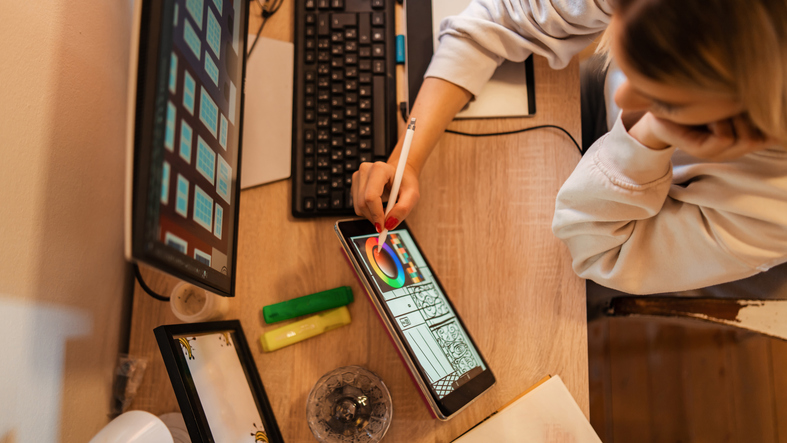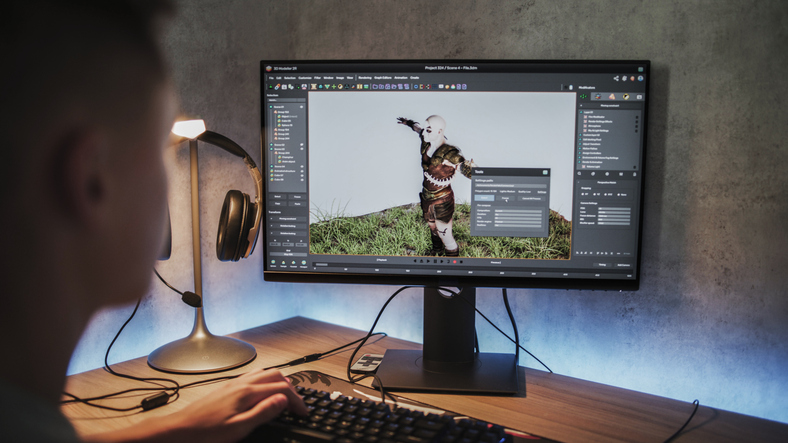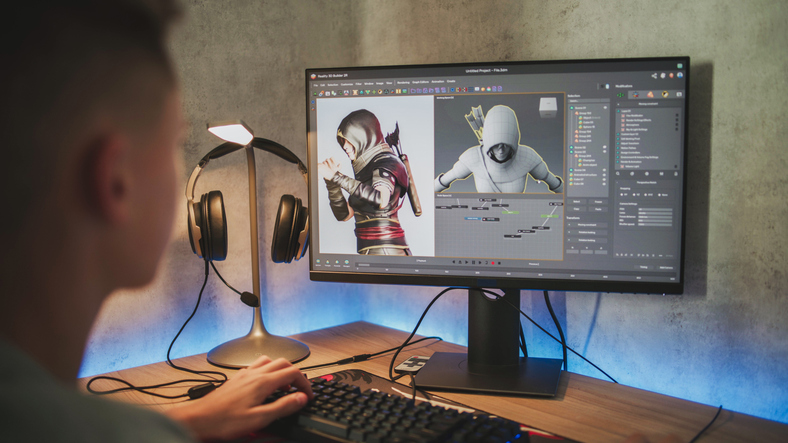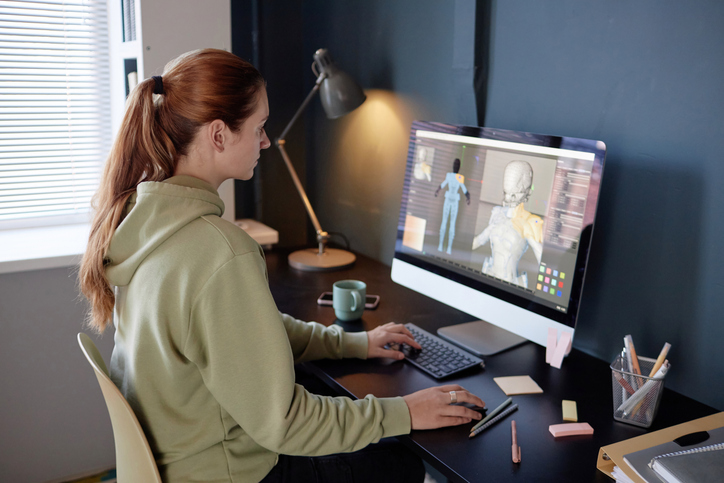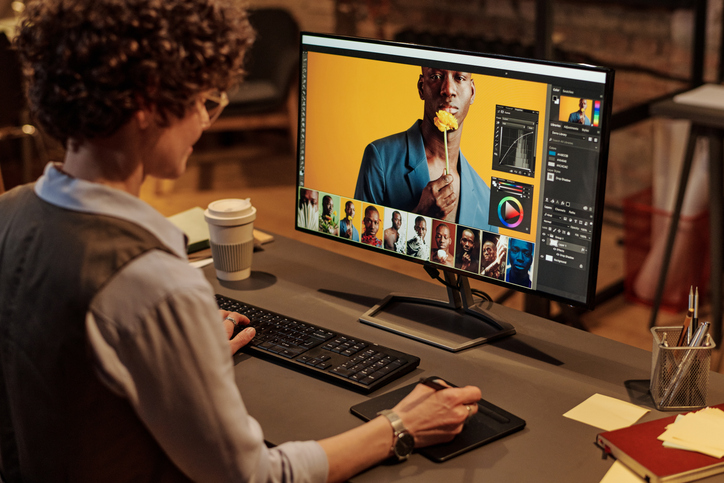Graphic design surrounds us everywhere from the apps we swipe daily to the advertisements lining the streets, the products on store shelves, and the websites we visit. But what exactly does a graphic designer do? Behind every engaging visual is a creative mind, blending artistry with technical expertise to create compelling visual content. If you're curious about stepping into the captivating world of graphic design, let’s explore what it involves, the skills needed, and why it remains a compelling career path, especially through a comprehensive program like VCAD’s Graphic Design Diploma.
What is Graphic Design?
Graphic design is a compelling blend of art and science dedicated to visual storytelling. At its core, graphic design focuses on the creative and strategic process of visually communicating ideas, information, and emotions effectively. Graphic designers skillfully combine elements such as typography, imagery, colour theory, and layouts to create powerful visual narratives that engage, inform, and inspire audiences.
The scope of graphic design is vast, encompassing everything from branding and corporate identity to advertising campaigns, digital content, packaging design, print media, environmental graphics, and interactive user experiences. Each project requires a tailored approach, demanding not only creative innovation but also strategic thinking and technical proficiency.
Graphic design plays a crucial role in shaping how audiences perceive and interact with brands and products. It transforms abstract concepts and complex messages into accessible, visually appealing formats that resonate deeply with target audiences. Ultimately, graphic design bridges the gap between businesses and their customers, enabling clear and meaningful communication that drives engagement, builds brand recognition, and influences consumer behaviour.
What Does a Graphic Designer Do Daily?
A day in the life of a graphic designer is dynamic, creative, and diverse. No two days are the same, as each project presents unique challenges and opportunities. Whether crafting visual identities for innovative startups, designing user-friendly interfaces for engaging websites, or developing impactful marketing campaigns, graphic designers continually flex their creative muscles.
Here’s an in-depth look at typical daily tasks:
1. Developing Creative Visual Concepts
Graphic designers start by conceptualizing ideas that visually communicate branding and advertising messages. They brainstorm creative strategies, sketch out preliminary ideas, and refine these concepts digitally using industry-standard tools. This phase involves research, experimentation with colour schemes, typography selection, and visual storytelling.
2. Designing Layouts for Digital and Print Media
A significant part of a designer's day involves creating and fine-tuning layouts for both digital platforms and traditional print materials. This could include designing engaging brochures, informative posters, captivating magazines, user-friendly websites, or interactive apps. Attention to detail, such as alignment, spacing, readability, and aesthetic appeal, is paramount in this stage.
3. Creating Graphics for Social Media
In the age of digital media, graphic designers regularly produce graphics tailored for social media platforms. They create visually compelling images, animated graphics, and infographics designed to boost audience engagement and promote brand visibility across platforms like Instagram, Facebook, LinkedIn, and Twitter.
4. Collaborating with Clients and Teams
Communication and teamwork play crucial roles. Designers regularly interact with clients and collaborate closely with marketing, branding, and product teams. They must interpret clients' visions, understand project objectives, and translate these insights into compelling visual assets, ensuring the final product aligns with the overall marketing strategy and brand identity.
5. Presenting Designs and Handling Feedback
Graphic designers routinely present their ideas and designs to clients or internal teams. This involves clearly communicating design choices, defending creative decisions, and effectively handling constructive feedback. Designers must be adaptable, using feedback to make necessary revisions and refinements, continually evolving their designs until the project goals are fully met.
6. Managing Multiple Projects and Deadlines
Juggling several projects simultaneously is common in graphic design. Designers must be skilled in project management, efficiently prioritizing tasks, managing time effectively, and consistently meeting tight deadlines. Staying organized and proactive is key to ensuring each project receives the attention it deserves.
7. Staying Updated with Industry Trends
Successful graphic designers keep their finger on the pulse of evolving design trends and emerging technologies. Regularly exploring new tools, techniques, and creative inspirations helps ensure their designs remain fresh, relevant, and innovative, setting their work apart from competitors.
Essential Skills for Successful Graphic Designers
Success in graphic design requires a mix of creative flair and technical precision. Here's a rundown of essential skills that form the backbone of any proficient graphic designer:
1. Creativity and Artistic Ability
At its core, graphic design is about creativity. A good designer can envision unique ideas and translate abstract concepts into visually appealing graphics.
2. Technical Proficiency
Mastery of industry-standard software is essential. Tools like Adobe Photoshop, Illustrator, InDesign, Premiere Pro, and After Effects are critical in shaping professional-quality visuals.
3. Typography and Layout Design
The arrangement of text and visuals significantly influences how effectively a message is communicated. Skilled designers understand typography nuances and layout principles to create aesthetically pleasing and functional designs.
4. Communication and Collaboration
Graphic designers often work with clients, marketers, and developers. Strong communication and interpersonal skills are necessary to clearly understand project requirements and feedback, adjusting accordingly.
5. Strategic Thinking and Problem-Solving
Graphic designers solve visual communication challenges daily. A strategic approach, combined with problem-solving abilities, ensures designs not only look great but also meet defined objectives.
6. Time Management
With multiple projects running concurrently, managing time efficiently and prioritizing tasks effectively is crucial for meeting tight deadlines.
VCAD’s Graphic Design Diploma program is carefully structured to nurture and refine these crucial skills, ensuring graduates are fully prepared for the industry demands.
Career Opportunities for Graphic Designers
Graphic design skills open diverse career pathways. Professionals can specialize based on personal interests and strengths, carving out a unique niche within this versatile field:
- Graphic Designer: Develops branding materials, digital content, advertisements, and promotional visuals.
- UX/UI Designer: Creates user-friendly digital experiences, ensuring websites and apps are both intuitive and engaging.
- Illustrator: Focuses on artistic creation for books, advertising campaigns, animations, and digital content.
- Animator: Designs motion graphics and animation, bringing static visuals to life in engaging ways.
- Publication Designer: Specializes in visually appealing layouts for books, magazines, and digital media.
Emerging opportunities like AI-Assisted UX/UI Designer and Digital Content Specialist further demonstrate the evolving landscape and diverse career possibilities graphic design offers.
Is Graphic Design a Good Career Choice in 2025?
As we move deeper into a digital age, graphic design continues to grow in importance and demand. Businesses increasingly recognize visual communication’s critical role in engaging consumers, enhancing user experiences, and promoting products.
Several key factors make graphic design a particularly attractive career choice in 2025:
High Demand: With businesses constantly needing visual content for websites, social media, marketing, and branding, the demand for skilled graphic designers continues to rise.
Creative Fulfillment and Versatility: Graphic design offers endless possibilities for creative expression and innovation, ranging from digital design to print and even environmental graphics.
Freelancing Flexibility: Graphic designers often enjoy flexible career options, including freelancing and remote work, enabling them to maintain an ideal work-life balance.
Technological Advancements: Emerging technologies such as AI and augmented reality are creating new opportunities, expanding the scope of graphic design beyond traditional boundaries.
Why Choose VCAD’s Graphic Design Diploma Program?
Choosing the right educational path is crucial for launching a successful career in graphic design. VCAD’s Graphic Design Diploma program offers a comprehensive, immersive, and practical approach that equips students with all the skills and knowledge needed to thrive in the dynamic design industry.
Comprehensive Curriculum
VCAD’s curriculum is thoughtfully designed to provide a robust foundation in all critical aspects of graphic design. Students learn colour theory, typography, digital photography, packaging design, corporate branding, advertising principles, and web design fundamentals. This extensive training ensures graduates can confidently tackle various creative projects, from branding and marketing campaigns to digital content creation and print media.
Industry-Standard Software Training
Proficiency with industry-standard software is indispensable for graphic designers. VCAD’s program includes extensive hands-on training with essential design tools such as Adobe Photoshop, Illustrator, InDesign, Premiere Pro, and After Effects. Students graduate fully capable of producing professional-quality work, equipped to meet and exceed industry expectations from day one.
Flexible Learning Options
Recognizing the diverse needs and lifestyles of today’s students, VCAD offers both online and campus-based learning options. This flexibility allows students to tailor their studies according to their personal schedules and commitments, making it easier for individuals to pursue their passion for design without compromising other responsibilities.
Mentorship from Industry Experts
One of the unique strengths of VCAD’s Graphic Design Diploma is the direct mentorship from seasoned industry professionals. These mentors bring real-world experience and practical insights directly into the classroom, providing students with valuable guidance, advice, and networking opportunities that are instrumental for career advancement.
Professional Portfolio Development
The creation of a professional portfolio is a key component of the program. Students develop and refine their portfolios throughout their studies, showcasing a diverse range of work that highlights their unique style, technical skills, and creativity. A well-crafted portfolio is essential for impressing potential employers and is often the deciding factor in job placements post-graduation.
Artificial Intelligence is revolutionizing many industries, graphic design included. However, rather than replacing graphic designers, AI is enhancing their abilities and efficiency.
Benefits of AI:
- Automates repetitive tasks, allowing designers to focus on creative aspects.
- Generates new ideas and variations swiftly, accelerating the creative process.
- Enables hyper-personalized designs tailored specifically to audience preferences.
Human Creativity Remains Irreplaceable: While AI assists significantly, it lacks emotional depth, cultural sensitivity, and the intuitive decision-making that humans inherently possess. Designers' ability to connect emotionally with their audience remains unmatched by technology.
At VCAD, students are trained not only to master traditional design skills but also to understand and leverage AI tools, preparing them comprehensively for future trends.
Final Thoughts
Graphic design is a powerful career choice that combines creative passion with practical application, offering numerous paths to personal fulfillment and professional success. Whether you're fascinated by brand creation, digital design, or the intersection of art and technology, the field promises ample opportunities and continual growth.
If you're ready to explore the world of graphic design, VCAD's Graphic Design Diploma is your gateway. With rigorous training, flexible study options, mentorship, and robust portfolio development, VCAD equips you to thrive in a dynamic, ever-evolving industry.
Begin your creative journey today, enroll in VCAD’s Graphic Design Diploma program and transform your artistic passion into a successful career!
